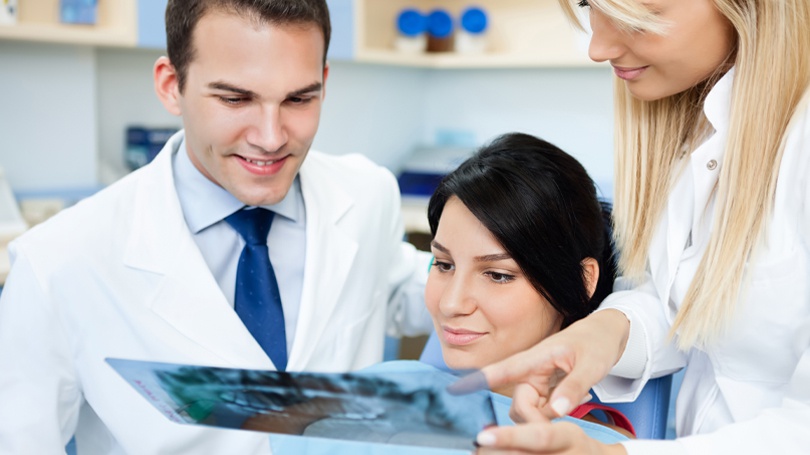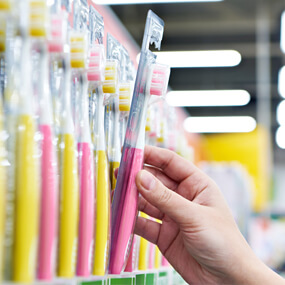How Modern Dentistry Came to Be

Modern dentists are highly trained specialists with many advanced technologies at their disposal. But dentistry has long fascinated humans, and evidence of dental drillings exist as far back as 7,000 B.C. In around 3,000 B.C., there lived an Egyptian dentist so renowned we know his name: Hesy-Re, and he practiced dentistry without running water, electricity, or anesthesia to numb any pain.
Dentistry of the Ancients
Those dental drillings that date to around 7,000 B.C. were found in Pakistan. Archaeologists unearthed teeth that had tiny holes in them. Those holes were made by human hand using flint drill bits, a tool of the time, and there was evidence that the holes had been made to relieve the patient of tooth decay. There was no evidence of a dental filling or similar technique, however.
The aforementioned Hesy-Re was a high official during the third dynasty of ancient Egypt. He earned many titles throughout his life, including Wer-ibeh-senjw—great one of the ivory cutters. Hesy-re is the earliest dentist historians know by name, and his trade was not unusual in ancient Egypt. Periodontal disease is evident in many Egyptian mummies, and historians have found numerous ancient Egyptian texts describing toothache cures, dental injuries and treatments, oral disease, and so forth.
Advancement of Dentistry in Early Greece
Many scientific advancements were made by the ancient Greeks, and these extended to dental care as well. Hippocrates—the father of modern medicine—wrote in great detail about a radical therapy he had developed to cure a patient of tooth pain. He recommended extracting the tooth, cauterizing the surrounding tissue, and using an ointment to soothe the surgical area while it healed.
Even Aristotle—among the greatest philosophers of all time—thought about dentistry, and his writings include his thoughts on tooth development, tooth decay, and gum disease. He even devised treatments, including the use of forceps to extract teeth and using wires to secure loose teeth.
Other important dental discoveries were made in Greece as well. The physician Claudius Galen is the first known to identify teeth as bone with nerves and blood vessels inside. Another physician—Diocles of Carystus—is the first known to have recommended oral hygiene: rubbing of the teeth and gums.
The Barber as Dentist
In the Middle Ages, monks were often the most educated, and the responsibilities of medicine generally fell to them. However, the Church began forbidding monks from extracting teeth and performing other surgeries, and so, those duties transitioned to local barbers.
Barbers already had skill with many types of knives and often served as assistants to the monks. When the monks were prohibited from performing, it was a rather natural progression at the time for the barbers to assume those duties. This meant that in addition to cutting hair and shaving beards, barbers extracted teeth, performed bloodletting, and even embalmed the dead.
The Dawn of Modern Dentistry
The dawn of modern dentistry is often attributed to a book written by Artzney Buchlein and published in Germany in 1530: “The Little Medicinal Book for All Kinds of Diseases and Infirmities of the Teeth.” Buchlein details oral hygiene, tooth extraction, and even procedures for gold fillings. In 1575, Ambrose Pare—a French doctor regarded by some historians as the father of surgery—included dental procedures when publishing his collected works.
Charles Allen published “The Operator for the Teeth” in 1685. It was the first educational textbook concerning dentistry published in English. It expanded beyond tooth extraction—which was the most common dental procedure of the day—and even discussed concepts of chairside manner and how to make a paste at home that could be used to whiten the teeth.
The Father of Modern Dentistry
Pierre Fauchard is the French dentist whom many historians consider to be the father of modern dentistry. In 1723, he published a notable work: “The Surgeon Dentist, A Treatise on Teeth.” This was the first time a published work had linked sugar to tooth decay, and it dispelled notions that evil spirits and tooth worms were the causes of toothaches and other dental issues.
Fauchard was integral to establishing dentistry as a distinct field of medicine. He often used his writing not just to explore dentistry techniques but to combine them into a system not just for treatments but preventative care. Some of the techniques he innovated are still fundamental today, including how dentists clean teeth, fill cavities, and use braces and dental prostheses.
Dentistry in the U.S.
John Baker was a British dentist who moved to the new world in 1766. He initially referred to himself as an Operator for the Teeth—presumably based on Charles Allen’s book—and he would treat patients in Boston, Rhode Island, New York, and eventually Virginia. His most notable patient was George Washington. Troubles with his teeth are a part of Washington’s legacy, and Baker made partial dentures for him out of ivory.
Long before Paul Revere would make history with his Midnight Ride, he studied dentistry with Baker. Baker taught Revere how to craft ivory dentures, and Revere eventually opened his own practice. During the war, Revere identified a corpse on the battlefield by a dental bridge that he had made, and this is one of the earliest known examples of forensic dentistry.
The Baltimore College of Dental Surgery opened its doors in 1840. It was the first dental college not just in the U.S. but in the world. Known today as the School of Dentistry at the University of Maryland, historians view it as a core step in establishing dentistry as a profession in the U.S.
Dr. Greene Vardiman Black was born in Illinois and studied to be a physician before transitioning to dentistry. Some historians deem him to be the father of modern dentistry. Black was a pioneer in patient comfort and bacteriology. He invented various dental tools, including the foot-powered dental drill, and his writings served as a foundation for modern dentistry and are still valued today.
Dentistry in the Modern Age
The American Dental Association is the oldest such organization in the world. The ADA supports both the public and dentists and has been integral to preserving dental knowledge, curating the modern understanding of the science and spreading awareness concerning oral hygiene, and so forth. The ADA informs the public through recommendations that are regularly revised and by giving the ADA Seal of Acceptance to products that meet its oral hygiene standards.
Enjoy the Best in Modern Dentistry
Dentistry has come a long way over the years. We now live in a time when computers are making dentistry more effective, efficient, and discomfort-free than ever before. Jeffrey D. Clark, DDS, not only specializes in top-quality cosmetic and restorative dental care but is committed to ongoing education and embracing the latest technologies and techniques. Schedule your appointment with Dr. Clark at Scottsdale Cosmetic Dentistry Excellence today by calling us at 480 585 1853.




